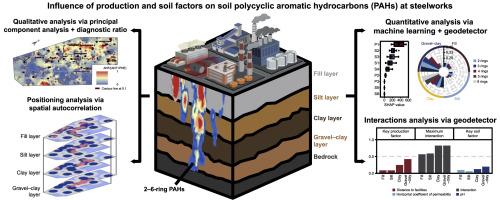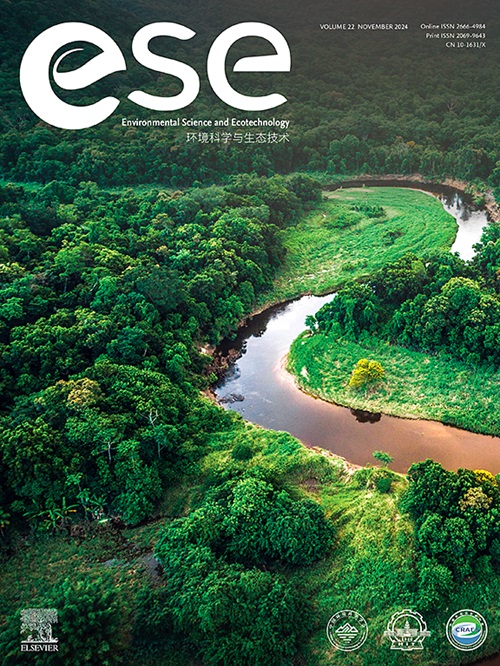钢铁厂土壤中多环芳烃的异质性、非线性和多因素相互作用
IF 14.3
1区 环境科学与生态学
Q1 ENVIRONMENTAL SCIENCES
引用次数: 0
摘要
工业多环芳烃(PAHs)污染威胁着全球土壤生态系统,由于其毒性和复杂的运输动力学,造成了持续的风险。在炼钢厂,多环芳烃的主要排放者,污染物分布源于生产活动和地质特征之间多方面的相互作用,使潜在机制的阐明变得复杂。以前的研究在很大程度上忽视了这些影响的内在异质性,而是关注全球关系,这可能会对污染驱动因素和多环芳烃迁移的评估产生偏差。在这里,我们使用集成了机器学习和空间分析的多维框架,展示了钢铁厂多环芳烃污染的异质性、非线性和多因素相互作用。应用于3339个土壤样本和9个影响因素,该框架显示与生产设施的距离是主要驱动因素,影响半径为60 m;生产因子对2 - 3环多环芳烃的影响强于对4 - 6环多环芳烃的影响,特别是在深度为9 ~ 20 m的较深土层。土壤水分和粘土含量协同控制多环芳烃在地层中的迁移,将框架的解释力从0.5提高到0.9,并能够精确描述动力学。这种模块化的方法不仅推进了对工业多环芳烃污染的机理见解,而且还为不同污染地点的有针对性的预防和修复策略提供了可扩展的指导。本文章由计算机程序翻译,如有差异,请以英文原文为准。

Heterogeneity, nonlinearity, and multifactor interactions of polycyclic aromatic hydrocarbons in steelworks soils
Industrial polycyclic aromatic hydrocarbons (PAHs) pollution threatens soil ecosystems worldwide, posing persistent risks due to their toxicity and intricate transport dynamics. In steelworks, a major PAH emitter, contaminant distribution arises from multifaceted interactions between production activities and geological features, complicating the elucidation of underlying mechanisms. Previous studies have largely overlooked the inherent heterogeneity in these influences, focusing instead on global relationships that may bias assessments of pollution drivers and PAH migration. Here we show heterogeneity, nonlinearity, and multifactor interactions in PAH contamination at a steelworks site using a multidimensional framework that integrates machine learning and spatial analysis. Applied to 3339 soil samples and nine influencing factors, the framework reveals distance to production facilities as the dominant driver, with a 60-m impact radius; production factors exert stronger effects on 2–3-ring PAHs than on 4–6-ring PAHs, particularly in deeper soil layers at depths of 9–20 m. Soil moisture and clay content synergistically control PAH mobility across strata, elevating the framework's explanatory power from 0.5 to 0.9 and enabling precise delineation of dynamics. This modular approach not only advances mechanistic insights into industrial PAH pollution but also provides scalable guidance for targeted prevention and remediation strategies across diverse contaminated sites.
求助全文
通过发布文献求助,成功后即可免费获取论文全文。
去求助
来源期刊

Environmental Science and Ecotechnology
Multiple-
CiteScore
20.40
自引率
6.30%
发文量
11
审稿时长
18 days
期刊介绍:
Environmental Science & Ecotechnology (ESE) is an international, open-access journal publishing original research in environmental science, engineering, ecotechnology, and related fields. Authors publishing in ESE can immediately, permanently, and freely share their work. They have license options and retain copyright. Published by Elsevier, ESE is co-organized by the Chinese Society for Environmental Sciences, Harbin Institute of Technology, and the Chinese Research Academy of Environmental Sciences, under the supervision of the China Association for Science and Technology.
 求助内容:
求助内容: 应助结果提醒方式:
应助结果提醒方式:


